The Effect of Performing Loans on the Profitability of UK Banks
VerifiedAdded on 2023/06/18
|30
|8336
|183
Report
AI Summary
This report investigates the impact of performing loans and financial indicators on the profitability of banks in the UK. It explores various financial variables such as loan-to-assets ratios, capital adequacy, and their effects on key profitability metrics like return on assets and return on equity. The study highlights the critical role of performing loans as a primary revenue source for banks and their positive correlation with profitability. It also addresses the negative impact of regulatory measures like capital adequacy on profitability. Through data analysis and thematic analysis, the report provides insights into the determinants of bank profitability within the UK banking sector, emphasizing the importance of managing loan portfolios effectively to ensure financial stability and growth. Desklib provides access to this report and many other resources for students.
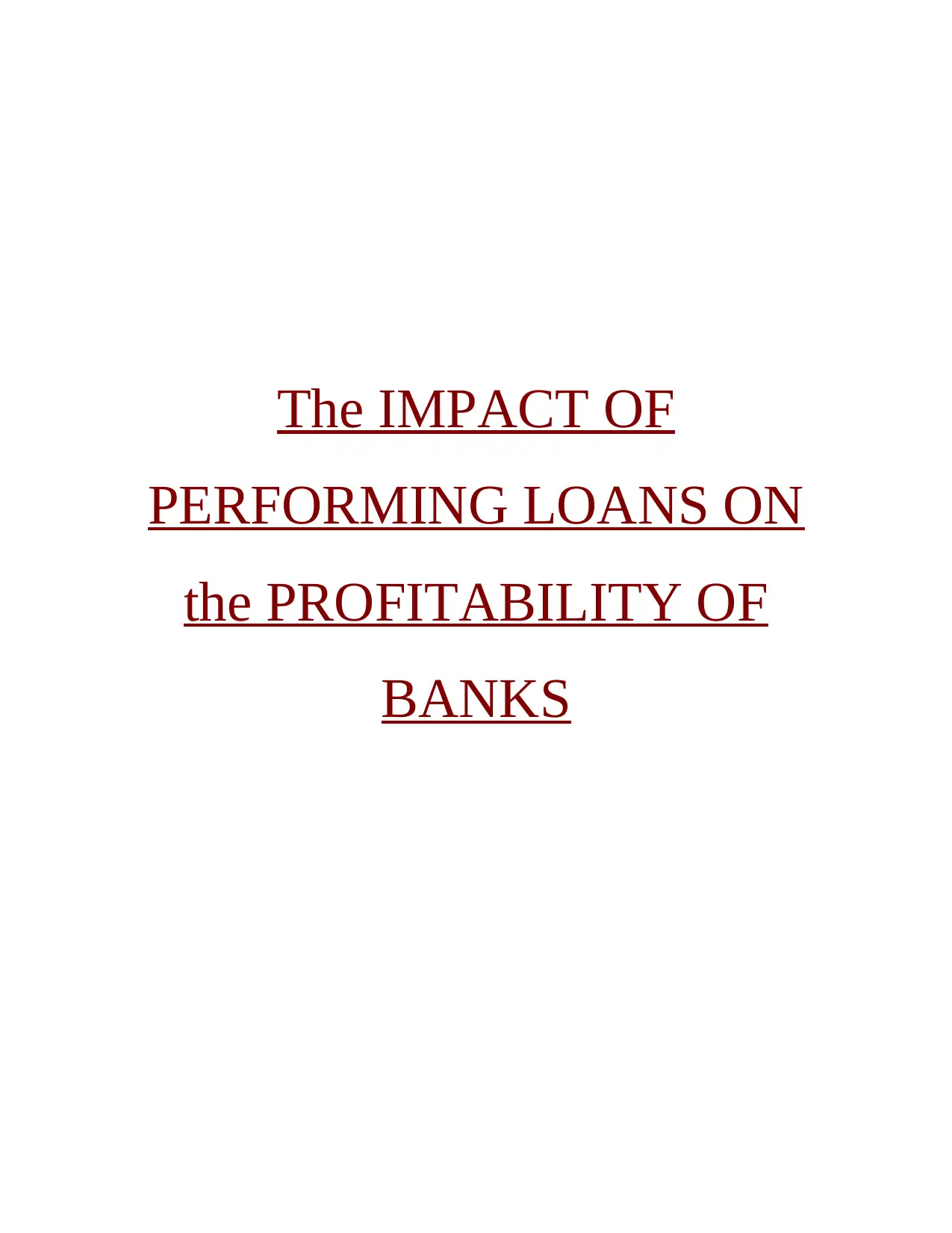
The IMPACT OF
PERFORMING LOANS ON
the PROFITABILITY OF
BANKS
PERFORMING LOANS ON
the PROFITABILITY OF
BANKS
Paraphrase This Document
Need a fresh take? Get an instant paraphrase of this document with our AI Paraphraser
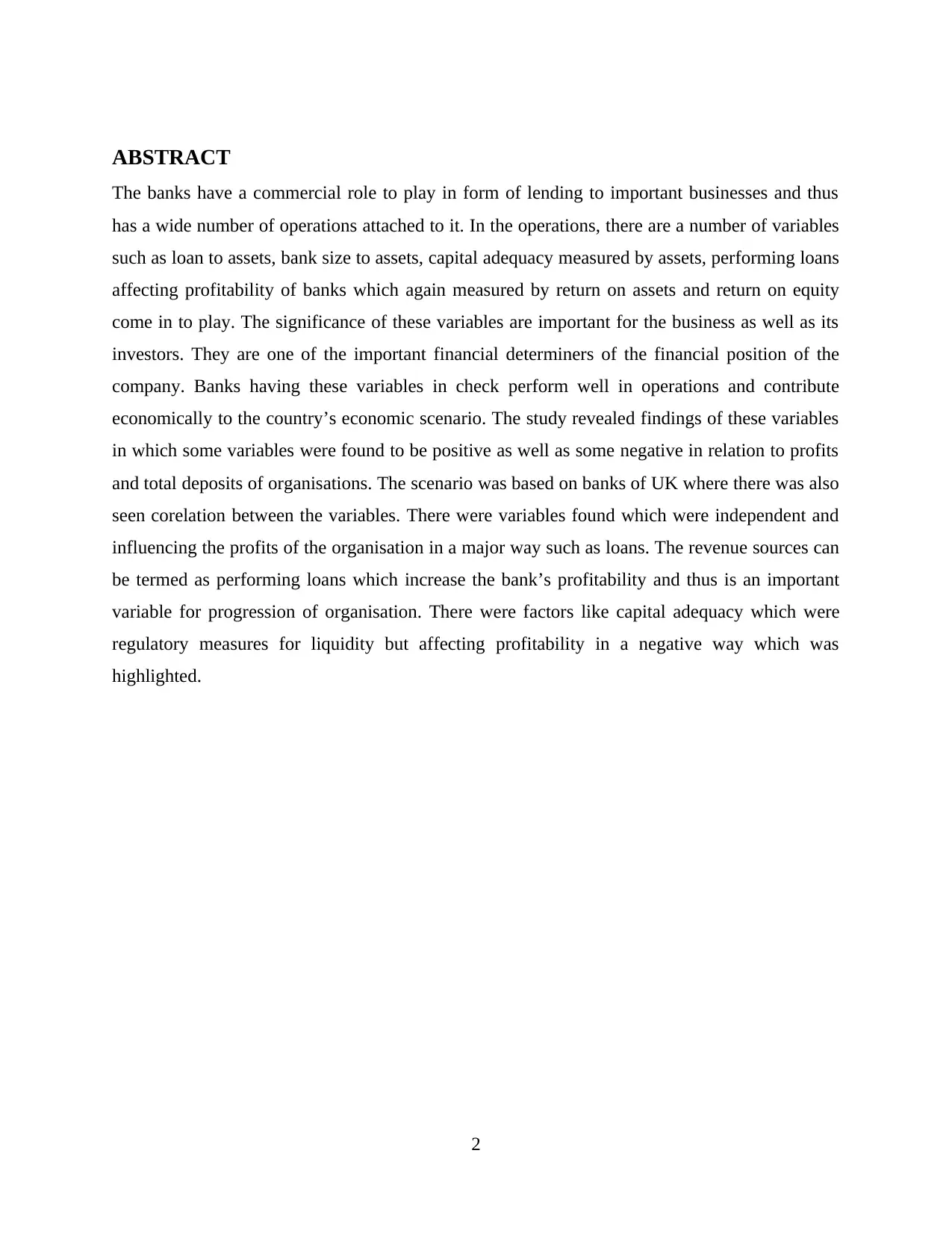
ABSTRACT
The banks have a commercial role to play in form of lending to important businesses and thus
has a wide number of operations attached to it. In the operations, there are a number of variables
such as loan to assets, bank size to assets, capital adequacy measured by assets, performing loans
affecting profitability of banks which again measured by return on assets and return on equity
come in to play. The significance of these variables are important for the business as well as its
investors. They are one of the important financial determiners of the financial position of the
company. Banks having these variables in check perform well in operations and contribute
economically to the country’s economic scenario. The study revealed findings of these variables
in which some variables were found to be positive as well as some negative in relation to profits
and total deposits of organisations. The scenario was based on banks of UK where there was also
seen corelation between the variables. There were variables found which were independent and
influencing the profits of the organisation in a major way such as loans. The revenue sources can
be termed as performing loans which increase the bank’s profitability and thus is an important
variable for progression of organisation. There were factors like capital adequacy which were
regulatory measures for liquidity but affecting profitability in a negative way which was
highlighted.
2
The banks have a commercial role to play in form of lending to important businesses and thus
has a wide number of operations attached to it. In the operations, there are a number of variables
such as loan to assets, bank size to assets, capital adequacy measured by assets, performing loans
affecting profitability of banks which again measured by return on assets and return on equity
come in to play. The significance of these variables are important for the business as well as its
investors. They are one of the important financial determiners of the financial position of the
company. Banks having these variables in check perform well in operations and contribute
economically to the country’s economic scenario. The study revealed findings of these variables
in which some variables were found to be positive as well as some negative in relation to profits
and total deposits of organisations. The scenario was based on banks of UK where there was also
seen corelation between the variables. There were variables found which were independent and
influencing the profits of the organisation in a major way such as loans. The revenue sources can
be termed as performing loans which increase the bank’s profitability and thus is an important
variable for progression of organisation. There were factors like capital adequacy which were
regulatory measures for liquidity but affecting profitability in a negative way which was
highlighted.
2
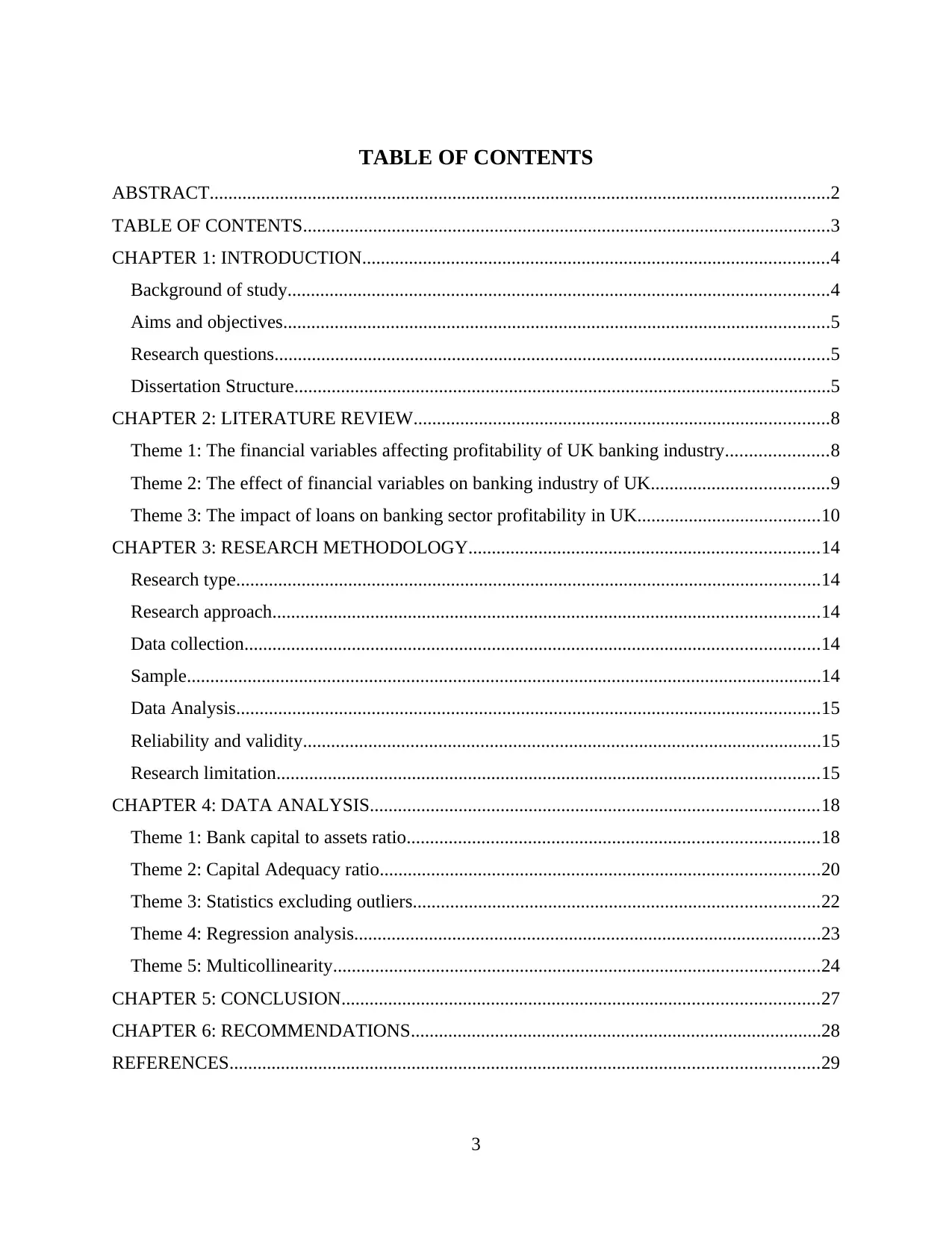
TABLE OF CONTENTS
ABSTRACT.....................................................................................................................................2
TABLE OF CONTENTS.................................................................................................................3
CHAPTER 1: INTRODUCTION....................................................................................................4
Background of study....................................................................................................................4
Aims and objectives.....................................................................................................................5
Research questions.......................................................................................................................5
Dissertation Structure...................................................................................................................5
CHAPTER 2: LITERATURE REVIEW.........................................................................................8
Theme 1: The financial variables affecting profitability of UK banking industry......................8
Theme 2: The effect of financial variables on banking industry of UK......................................9
Theme 3: The impact of loans on banking sector profitability in UK.......................................10
CHAPTER 3: RESEARCH METHODOLOGY...........................................................................14
Research type.............................................................................................................................14
Research approach.....................................................................................................................14
Data collection...........................................................................................................................14
Sample........................................................................................................................................14
Data Analysis.............................................................................................................................15
Reliability and validity...............................................................................................................15
Research limitation....................................................................................................................15
CHAPTER 4: DATA ANALYSIS................................................................................................18
Theme 1: Bank capital to assets ratio........................................................................................18
Theme 2: Capital Adequacy ratio..............................................................................................20
Theme 3: Statistics excluding outliers.......................................................................................22
Theme 4: Regression analysis....................................................................................................23
Theme 5: Multicollinearity........................................................................................................24
CHAPTER 5: CONCLUSION......................................................................................................27
CHAPTER 6: RECOMMENDATIONS........................................................................................28
REFERENCES..............................................................................................................................29
3
ABSTRACT.....................................................................................................................................2
TABLE OF CONTENTS.................................................................................................................3
CHAPTER 1: INTRODUCTION....................................................................................................4
Background of study....................................................................................................................4
Aims and objectives.....................................................................................................................5
Research questions.......................................................................................................................5
Dissertation Structure...................................................................................................................5
CHAPTER 2: LITERATURE REVIEW.........................................................................................8
Theme 1: The financial variables affecting profitability of UK banking industry......................8
Theme 2: The effect of financial variables on banking industry of UK......................................9
Theme 3: The impact of loans on banking sector profitability in UK.......................................10
CHAPTER 3: RESEARCH METHODOLOGY...........................................................................14
Research type.............................................................................................................................14
Research approach.....................................................................................................................14
Data collection...........................................................................................................................14
Sample........................................................................................................................................14
Data Analysis.............................................................................................................................15
Reliability and validity...............................................................................................................15
Research limitation....................................................................................................................15
CHAPTER 4: DATA ANALYSIS................................................................................................18
Theme 1: Bank capital to assets ratio........................................................................................18
Theme 2: Capital Adequacy ratio..............................................................................................20
Theme 3: Statistics excluding outliers.......................................................................................22
Theme 4: Regression analysis....................................................................................................23
Theme 5: Multicollinearity........................................................................................................24
CHAPTER 5: CONCLUSION......................................................................................................27
CHAPTER 6: RECOMMENDATIONS........................................................................................28
REFERENCES..............................................................................................................................29
3
⊘ This is a preview!⊘
Do you want full access?
Subscribe today to unlock all pages.

Trusted by 1+ million students worldwide
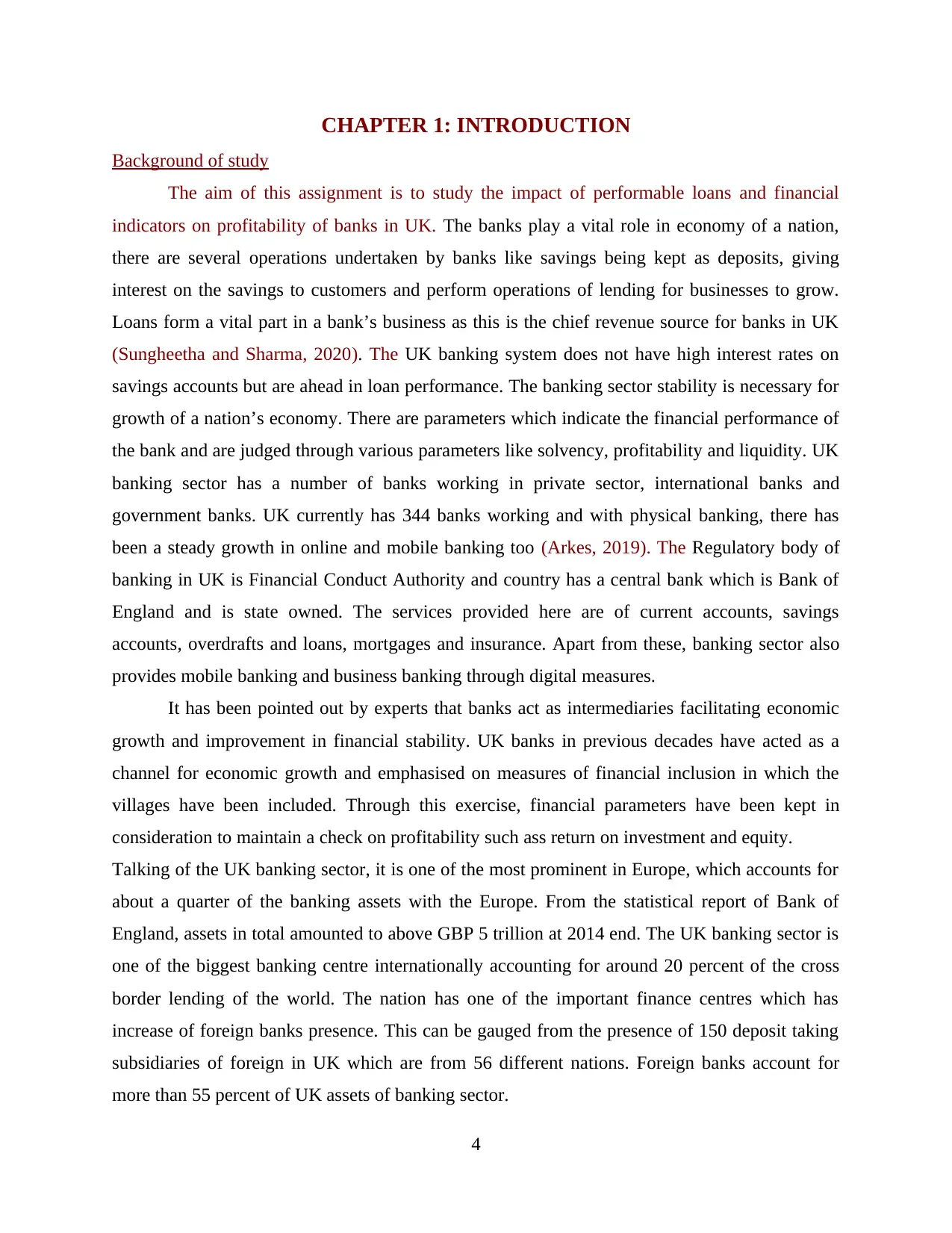
CHAPTER 1: INTRODUCTION
Background of study
The aim of this assignment is to study the impact of performable loans and financial
indicators on profitability of banks in UK. The banks play a vital role in economy of a nation,
there are several operations undertaken by banks like savings being kept as deposits, giving
interest on the savings to customers and perform operations of lending for businesses to grow.
Loans form a vital part in a bank’s business as this is the chief revenue source for banks in UK
(Sungheetha and Sharma, 2020). The UK banking system does not have high interest rates on
savings accounts but are ahead in loan performance. The banking sector stability is necessary for
growth of a nation’s economy. There are parameters which indicate the financial performance of
the bank and are judged through various parameters like solvency, profitability and liquidity. UK
banking sector has a number of banks working in private sector, international banks and
government banks. UK currently has 344 banks working and with physical banking, there has
been a steady growth in online and mobile banking too (Arkes, 2019). The Regulatory body of
banking in UK is Financial Conduct Authority and country has a central bank which is Bank of
England and is state owned. The services provided here are of current accounts, savings
accounts, overdrafts and loans, mortgages and insurance. Apart from these, banking sector also
provides mobile banking and business banking through digital measures.
It has been pointed out by experts that banks act as intermediaries facilitating economic
growth and improvement in financial stability. UK banks in previous decades have acted as a
channel for economic growth and emphasised on measures of financial inclusion in which the
villages have been included. Through this exercise, financial parameters have been kept in
consideration to maintain a check on profitability such ass return on investment and equity.
Talking of the UK banking sector, it is one of the most prominent in Europe, which accounts for
about a quarter of the banking assets with the Europe. From the statistical report of Bank of
England, assets in total amounted to above GBP 5 trillion at 2014 end. The UK banking sector is
one of the biggest banking centre internationally accounting for around 20 percent of the cross
border lending of the world. The nation has one of the important finance centres which has
increase of foreign banks presence. This can be gauged from the presence of 150 deposit taking
subsidiaries of foreign in UK which are from 56 different nations. Foreign banks account for
more than 55 percent of UK assets of banking sector.
4
Background of study
The aim of this assignment is to study the impact of performable loans and financial
indicators on profitability of banks in UK. The banks play a vital role in economy of a nation,
there are several operations undertaken by banks like savings being kept as deposits, giving
interest on the savings to customers and perform operations of lending for businesses to grow.
Loans form a vital part in a bank’s business as this is the chief revenue source for banks in UK
(Sungheetha and Sharma, 2020). The UK banking system does not have high interest rates on
savings accounts but are ahead in loan performance. The banking sector stability is necessary for
growth of a nation’s economy. There are parameters which indicate the financial performance of
the bank and are judged through various parameters like solvency, profitability and liquidity. UK
banking sector has a number of banks working in private sector, international banks and
government banks. UK currently has 344 banks working and with physical banking, there has
been a steady growth in online and mobile banking too (Arkes, 2019). The Regulatory body of
banking in UK is Financial Conduct Authority and country has a central bank which is Bank of
England and is state owned. The services provided here are of current accounts, savings
accounts, overdrafts and loans, mortgages and insurance. Apart from these, banking sector also
provides mobile banking and business banking through digital measures.
It has been pointed out by experts that banks act as intermediaries facilitating economic
growth and improvement in financial stability. UK banks in previous decades have acted as a
channel for economic growth and emphasised on measures of financial inclusion in which the
villages have been included. Through this exercise, financial parameters have been kept in
consideration to maintain a check on profitability such ass return on investment and equity.
Talking of the UK banking sector, it is one of the most prominent in Europe, which accounts for
about a quarter of the banking assets with the Europe. From the statistical report of Bank of
England, assets in total amounted to above GBP 5 trillion at 2014 end. The UK banking sector is
one of the biggest banking centre internationally accounting for around 20 percent of the cross
border lending of the world. The nation has one of the important finance centres which has
increase of foreign banks presence. This can be gauged from the presence of 150 deposit taking
subsidiaries of foreign in UK which are from 56 different nations. Foreign banks account for
more than 55 percent of UK assets of banking sector.
4
Paraphrase This Document
Need a fresh take? Get an instant paraphrase of this document with our AI Paraphraser
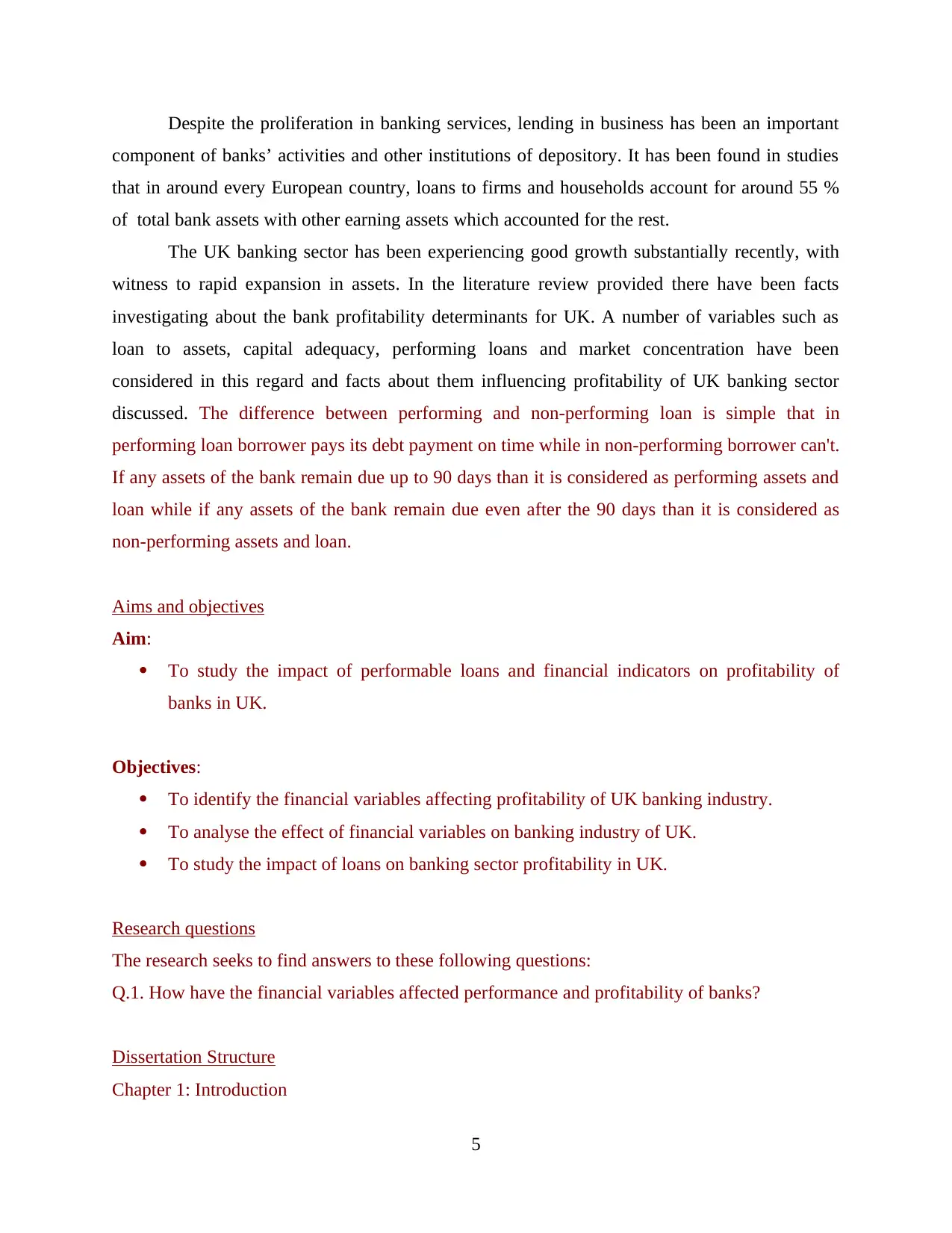
Despite the proliferation in banking services, lending in business has been an important
component of banks’ activities and other institutions of depository. It has been found in studies
that in around every European country, loans to firms and households account for around 55 %
of total bank assets with other earning assets which accounted for the rest.
The UK banking sector has been experiencing good growth substantially recently, with
witness to rapid expansion in assets. In the literature review provided there have been facts
investigating about the bank profitability determinants for UK. A number of variables such as
loan to assets, capital adequacy, performing loans and market concentration have been
considered in this regard and facts about them influencing profitability of UK banking sector
discussed. The difference between performing and non-performing loan is simple that in
performing loan borrower pays its debt payment on time while in non-performing borrower can't.
If any assets of the bank remain due up to 90 days than it is considered as performing assets and
loan while if any assets of the bank remain due even after the 90 days than it is considered as
non-performing assets and loan.
Aims and objectives
Aim:
To study the impact of performable loans and financial indicators on profitability of
banks in UK.
Objectives:
To identify the financial variables affecting profitability of UK banking industry.
To analyse the effect of financial variables on banking industry of UK.
To study the impact of loans on banking sector profitability in UK.
Research questions
The research seeks to find answers to these following questions:
Q.1. How have the financial variables affected performance and profitability of banks?
Dissertation Structure
Chapter 1: Introduction
5
component of banks’ activities and other institutions of depository. It has been found in studies
that in around every European country, loans to firms and households account for around 55 %
of total bank assets with other earning assets which accounted for the rest.
The UK banking sector has been experiencing good growth substantially recently, with
witness to rapid expansion in assets. In the literature review provided there have been facts
investigating about the bank profitability determinants for UK. A number of variables such as
loan to assets, capital adequacy, performing loans and market concentration have been
considered in this regard and facts about them influencing profitability of UK banking sector
discussed. The difference between performing and non-performing loan is simple that in
performing loan borrower pays its debt payment on time while in non-performing borrower can't.
If any assets of the bank remain due up to 90 days than it is considered as performing assets and
loan while if any assets of the bank remain due even after the 90 days than it is considered as
non-performing assets and loan.
Aims and objectives
Aim:
To study the impact of performable loans and financial indicators on profitability of
banks in UK.
Objectives:
To identify the financial variables affecting profitability of UK banking industry.
To analyse the effect of financial variables on banking industry of UK.
To study the impact of loans on banking sector profitability in UK.
Research questions
The research seeks to find answers to these following questions:
Q.1. How have the financial variables affected performance and profitability of banks?
Dissertation Structure
Chapter 1: Introduction
5
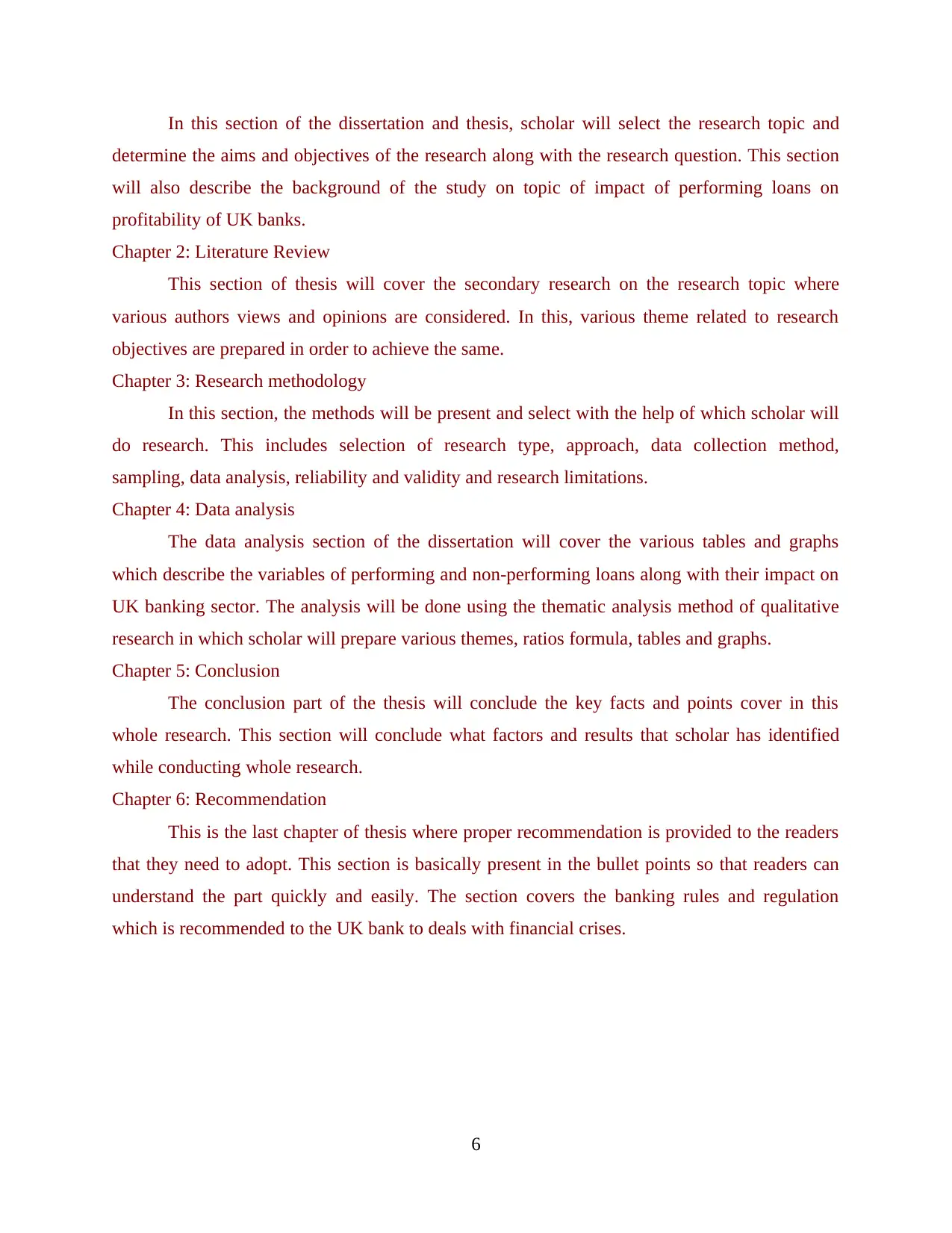
In this section of the dissertation and thesis, scholar will select the research topic and
determine the aims and objectives of the research along with the research question. This section
will also describe the background of the study on topic of impact of performing loans on
profitability of UK banks.
Chapter 2: Literature Review
This section of thesis will cover the secondary research on the research topic where
various authors views and opinions are considered. In this, various theme related to research
objectives are prepared in order to achieve the same.
Chapter 3: Research methodology
In this section, the methods will be present and select with the help of which scholar will
do research. This includes selection of research type, approach, data collection method,
sampling, data analysis, reliability and validity and research limitations.
Chapter 4: Data analysis
The data analysis section of the dissertation will cover the various tables and graphs
which describe the variables of performing and non-performing loans along with their impact on
UK banking sector. The analysis will be done using the thematic analysis method of qualitative
research in which scholar will prepare various themes, ratios formula, tables and graphs.
Chapter 5: Conclusion
The conclusion part of the thesis will conclude the key facts and points cover in this
whole research. This section will conclude what factors and results that scholar has identified
while conducting whole research.
Chapter 6: Recommendation
This is the last chapter of thesis where proper recommendation is provided to the readers
that they need to adopt. This section is basically present in the bullet points so that readers can
understand the part quickly and easily. The section covers the banking rules and regulation
which is recommended to the UK bank to deals with financial crises.
6
determine the aims and objectives of the research along with the research question. This section
will also describe the background of the study on topic of impact of performing loans on
profitability of UK banks.
Chapter 2: Literature Review
This section of thesis will cover the secondary research on the research topic where
various authors views and opinions are considered. In this, various theme related to research
objectives are prepared in order to achieve the same.
Chapter 3: Research methodology
In this section, the methods will be present and select with the help of which scholar will
do research. This includes selection of research type, approach, data collection method,
sampling, data analysis, reliability and validity and research limitations.
Chapter 4: Data analysis
The data analysis section of the dissertation will cover the various tables and graphs
which describe the variables of performing and non-performing loans along with their impact on
UK banking sector. The analysis will be done using the thematic analysis method of qualitative
research in which scholar will prepare various themes, ratios formula, tables and graphs.
Chapter 5: Conclusion
The conclusion part of the thesis will conclude the key facts and points cover in this
whole research. This section will conclude what factors and results that scholar has identified
while conducting whole research.
Chapter 6: Recommendation
This is the last chapter of thesis where proper recommendation is provided to the readers
that they need to adopt. This section is basically present in the bullet points so that readers can
understand the part quickly and easily. The section covers the banking rules and regulation
which is recommended to the UK bank to deals with financial crises.
6
⊘ This is a preview!⊘
Do you want full access?
Subscribe today to unlock all pages.

Trusted by 1+ million students worldwide

7
Paraphrase This Document
Need a fresh take? Get an instant paraphrase of this document with our AI Paraphraser
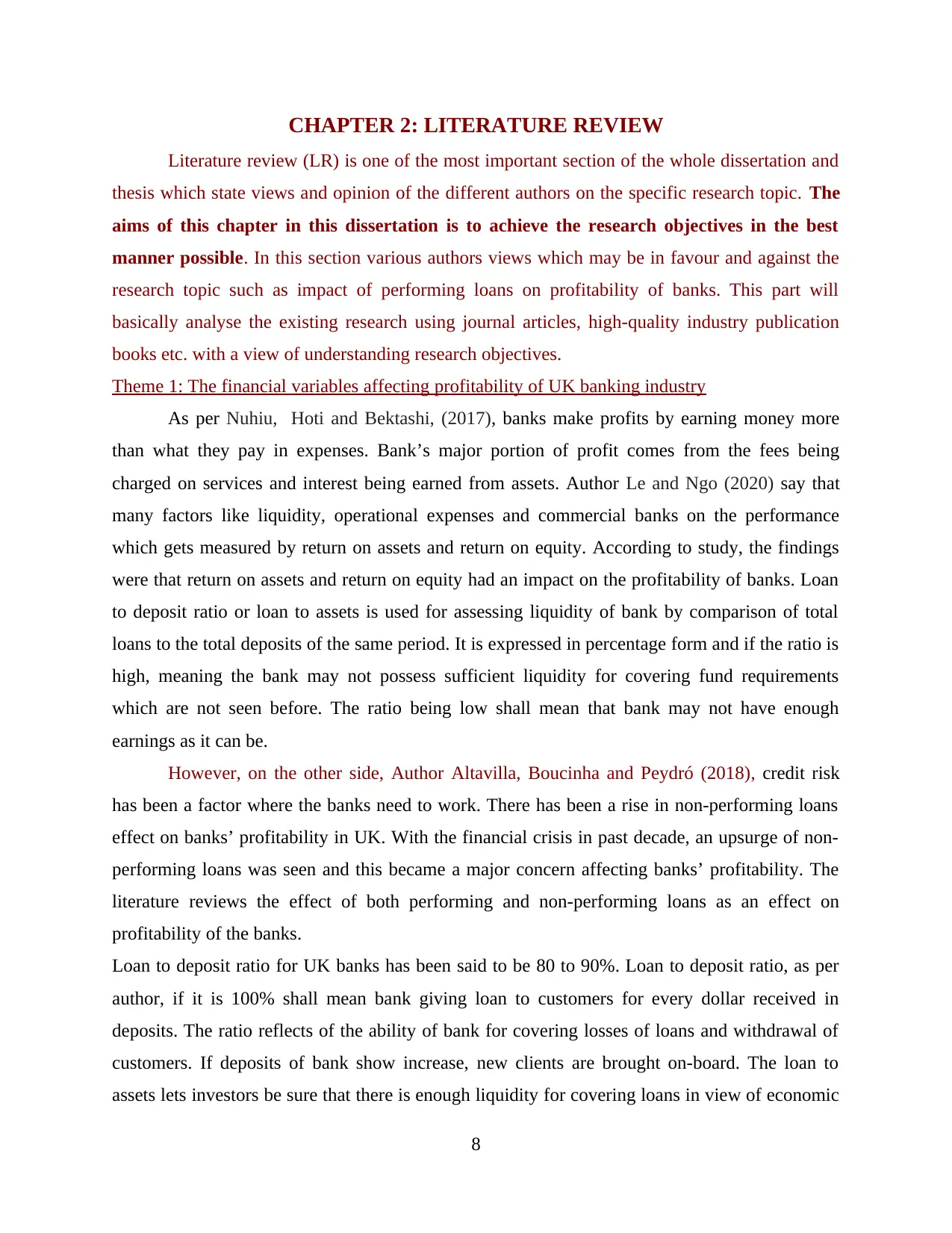
CHAPTER 2: LITERATURE REVIEW
Literature review (LR) is one of the most important section of the whole dissertation and
thesis which state views and opinion of the different authors on the specific research topic. The
aims of this chapter in this dissertation is to achieve the research objectives in the best
manner possible. In this section various authors views which may be in favour and against the
research topic such as impact of performing loans on profitability of banks. This part will
basically analyse the existing research using journal articles, high-quality industry publication
books etc. with a view of understanding research objectives.
Theme 1: The financial variables affecting profitability of UK banking industry
As per Nuhiu, Hoti and Bektashi, (2017), banks make profits by earning money more
than what they pay in expenses. Bank’s major portion of profit comes from the fees being
charged on services and interest being earned from assets. Author Le and Ngo (2020) say that
many factors like liquidity, operational expenses and commercial banks on the performance
which gets measured by return on assets and return on equity. According to study, the findings
were that return on assets and return on equity had an impact on the profitability of banks. Loan
to deposit ratio or loan to assets is used for assessing liquidity of bank by comparison of total
loans to the total deposits of the same period. It is expressed in percentage form and if the ratio is
high, meaning the bank may not possess sufficient liquidity for covering fund requirements
which are not seen before. The ratio being low shall mean that bank may not have enough
earnings as it can be.
However, on the other side, Author Altavilla, Boucinha and Peydró (2018), credit risk
has been a factor where the banks need to work. There has been a rise in non-performing loans
effect on banks’ profitability in UK. With the financial crisis in past decade, an upsurge of non-
performing loans was seen and this became a major concern affecting banks’ profitability. The
literature reviews the effect of both performing and non-performing loans as an effect on
profitability of the banks.
Loan to deposit ratio for UK banks has been said to be 80 to 90%. Loan to deposit ratio, as per
author, if it is 100% shall mean bank giving loan to customers for every dollar received in
deposits. The ratio reflects of the ability of bank for covering losses of loans and withdrawal of
customers. If deposits of bank show increase, new clients are brought on-board. The loan to
assets lets investors be sure that there is enough liquidity for covering loans in view of economic
8
Literature review (LR) is one of the most important section of the whole dissertation and
thesis which state views and opinion of the different authors on the specific research topic. The
aims of this chapter in this dissertation is to achieve the research objectives in the best
manner possible. In this section various authors views which may be in favour and against the
research topic such as impact of performing loans on profitability of banks. This part will
basically analyse the existing research using journal articles, high-quality industry publication
books etc. with a view of understanding research objectives.
Theme 1: The financial variables affecting profitability of UK banking industry
As per Nuhiu, Hoti and Bektashi, (2017), banks make profits by earning money more
than what they pay in expenses. Bank’s major portion of profit comes from the fees being
charged on services and interest being earned from assets. Author Le and Ngo (2020) say that
many factors like liquidity, operational expenses and commercial banks on the performance
which gets measured by return on assets and return on equity. According to study, the findings
were that return on assets and return on equity had an impact on the profitability of banks. Loan
to deposit ratio or loan to assets is used for assessing liquidity of bank by comparison of total
loans to the total deposits of the same period. It is expressed in percentage form and if the ratio is
high, meaning the bank may not possess sufficient liquidity for covering fund requirements
which are not seen before. The ratio being low shall mean that bank may not have enough
earnings as it can be.
However, on the other side, Author Altavilla, Boucinha and Peydró (2018), credit risk
has been a factor where the banks need to work. There has been a rise in non-performing loans
effect on banks’ profitability in UK. With the financial crisis in past decade, an upsurge of non-
performing loans was seen and this became a major concern affecting banks’ profitability. The
literature reviews the effect of both performing and non-performing loans as an effect on
profitability of the banks.
Loan to deposit ratio for UK banks has been said to be 80 to 90%. Loan to deposit ratio, as per
author, if it is 100% shall mean bank giving loan to customers for every dollar received in
deposits. The ratio reflects of the ability of bank for covering losses of loans and withdrawal of
customers. If deposits of bank show increase, new clients are brought on-board. The loan to
assets lets investors be sure that there is enough liquidity for covering loans in view of economic
8
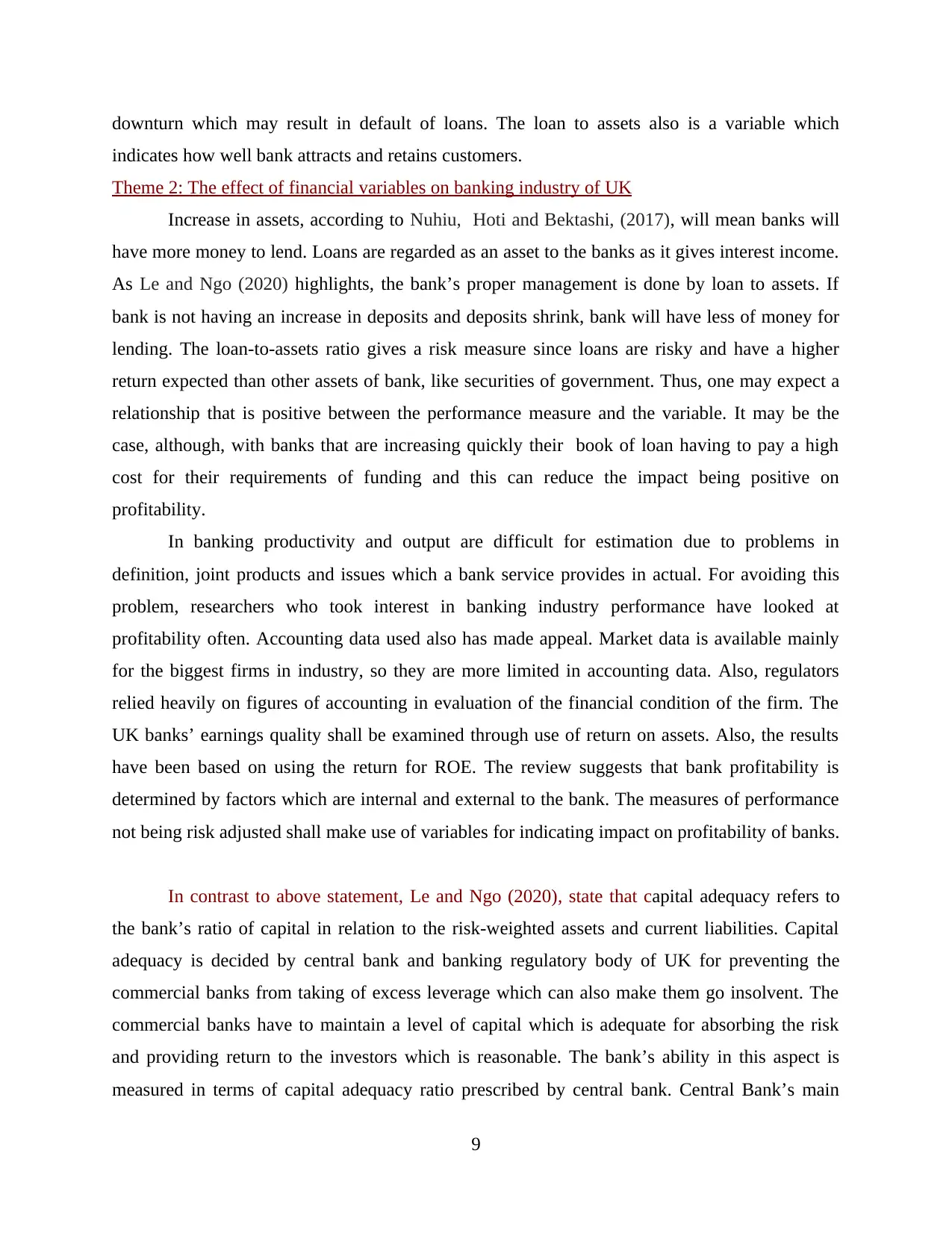
downturn which may result in default of loans. The loan to assets also is a variable which
indicates how well bank attracts and retains customers.
Theme 2: The effect of financial variables on banking industry of UK
Increase in assets, according to Nuhiu, Hoti and Bektashi, (2017), will mean banks will
have more money to lend. Loans are regarded as an asset to the banks as it gives interest income.
As Le and Ngo (2020) highlights, the bank’s proper management is done by loan to assets. If
bank is not having an increase in deposits and deposits shrink, bank will have less of money for
lending. The loan-to-assets ratio gives a risk measure since loans are risky and have a higher
return expected than other assets of bank, like securities of government. Thus, one may expect a
relationship that is positive between the performance measure and the variable. It may be the
case, although, with banks that are increasing quickly their book of loan having to pay a high
cost for their requirements of funding and this can reduce the impact being positive on
profitability.
In banking productivity and output are difficult for estimation due to problems in
definition, joint products and issues which a bank service provides in actual. For avoiding this
problem, researchers who took interest in banking industry performance have looked at
profitability often. Accounting data used also has made appeal. Market data is available mainly
for the biggest firms in industry, so they are more limited in accounting data. Also, regulators
relied heavily on figures of accounting in evaluation of the financial condition of the firm. The
UK banks’ earnings quality shall be examined through use of return on assets. Also, the results
have been based on using the return for ROE. The review suggests that bank profitability is
determined by factors which are internal and external to the bank. The measures of performance
not being risk adjusted shall make use of variables for indicating impact on profitability of banks.
In contrast to above statement, Le and Ngo (2020), state that capital adequacy refers to
the bank’s ratio of capital in relation to the risk-weighted assets and current liabilities. Capital
adequacy is decided by central bank and banking regulatory body of UK for preventing the
commercial banks from taking of excess leverage which can also make them go insolvent. The
commercial banks have to maintain a level of capital which is adequate for absorbing the risk
and providing return to the investors which is reasonable. The bank’s ability in this aspect is
measured in terms of capital adequacy ratio prescribed by central bank. Central Bank’s main
9
indicates how well bank attracts and retains customers.
Theme 2: The effect of financial variables on banking industry of UK
Increase in assets, according to Nuhiu, Hoti and Bektashi, (2017), will mean banks will
have more money to lend. Loans are regarded as an asset to the banks as it gives interest income.
As Le and Ngo (2020) highlights, the bank’s proper management is done by loan to assets. If
bank is not having an increase in deposits and deposits shrink, bank will have less of money for
lending. The loan-to-assets ratio gives a risk measure since loans are risky and have a higher
return expected than other assets of bank, like securities of government. Thus, one may expect a
relationship that is positive between the performance measure and the variable. It may be the
case, although, with banks that are increasing quickly their book of loan having to pay a high
cost for their requirements of funding and this can reduce the impact being positive on
profitability.
In banking productivity and output are difficult for estimation due to problems in
definition, joint products and issues which a bank service provides in actual. For avoiding this
problem, researchers who took interest in banking industry performance have looked at
profitability often. Accounting data used also has made appeal. Market data is available mainly
for the biggest firms in industry, so they are more limited in accounting data. Also, regulators
relied heavily on figures of accounting in evaluation of the financial condition of the firm. The
UK banks’ earnings quality shall be examined through use of return on assets. Also, the results
have been based on using the return for ROE. The review suggests that bank profitability is
determined by factors which are internal and external to the bank. The measures of performance
not being risk adjusted shall make use of variables for indicating impact on profitability of banks.
In contrast to above statement, Le and Ngo (2020), state that capital adequacy refers to
the bank’s ratio of capital in relation to the risk-weighted assets and current liabilities. Capital
adequacy is decided by central bank and banking regulatory body of UK for preventing the
commercial banks from taking of excess leverage which can also make them go insolvent. The
commercial banks have to maintain a level of capital which is adequate for absorbing the risk
and providing return to the investors which is reasonable. The bank’s ability in this aspect is
measured in terms of capital adequacy ratio prescribed by central bank. Central Bank’s main
9
⊘ This is a preview!⊘
Do you want full access?
Subscribe today to unlock all pages.

Trusted by 1+ million students worldwide
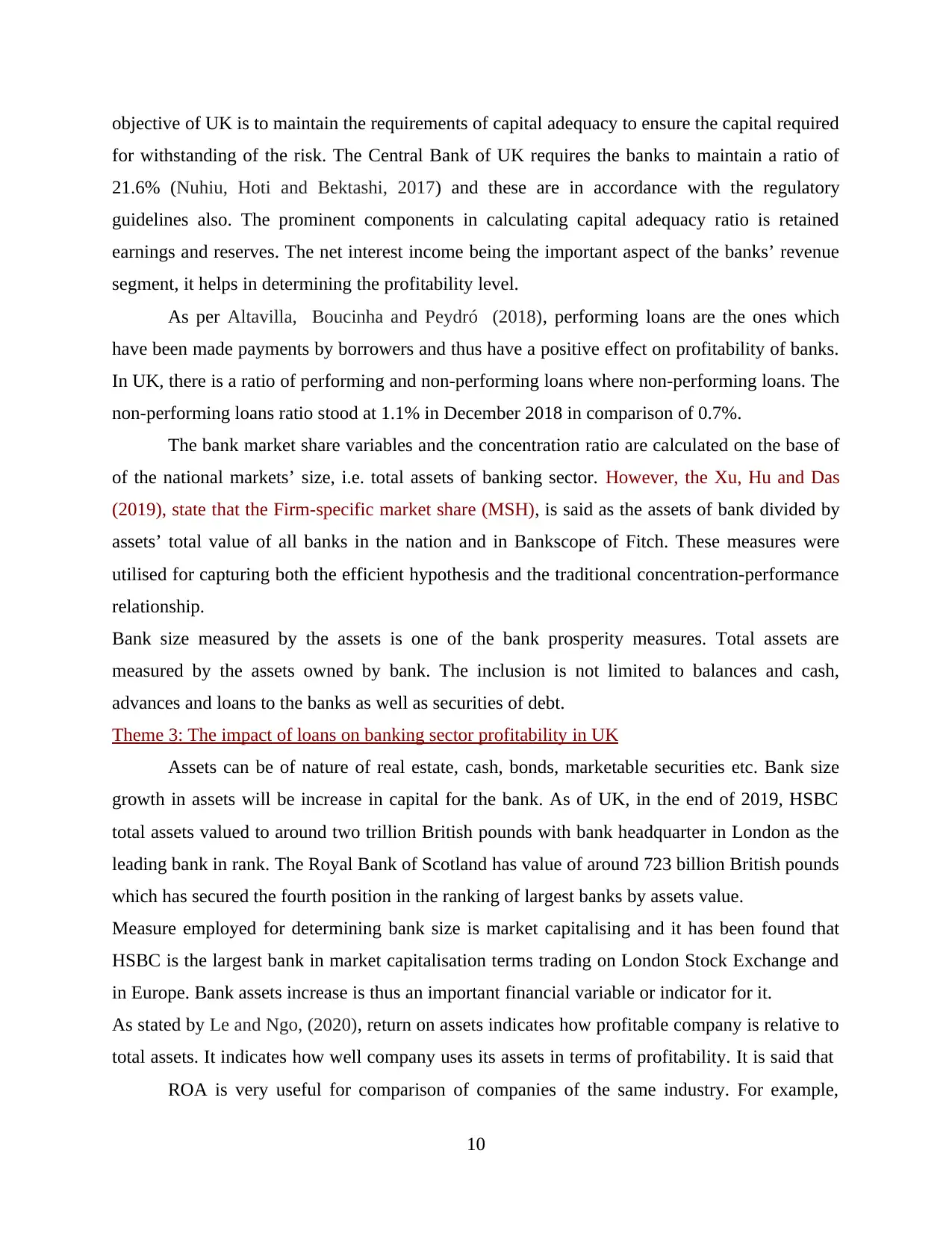
objective of UK is to maintain the requirements of capital adequacy to ensure the capital required
for withstanding of the risk. The Central Bank of UK requires the banks to maintain a ratio of
21.6% (Nuhiu, Hoti and Bektashi, 2017) and these are in accordance with the regulatory
guidelines also. The prominent components in calculating capital adequacy ratio is retained
earnings and reserves. The net interest income being the important aspect of the banks’ revenue
segment, it helps in determining the profitability level.
As per Altavilla, Boucinha and Peydró (2018), performing loans are the ones which
have been made payments by borrowers and thus have a positive effect on profitability of banks.
In UK, there is a ratio of performing and non-performing loans where non-performing loans. The
non-performing loans ratio stood at 1.1% in December 2018 in comparison of 0.7%.
The bank market share variables and the concentration ratio are calculated on the base of
of the national markets’ size, i.e. total assets of banking sector. However, the Xu, Hu and Das
(2019), state that the Firm-specific market share (MSH), is said as the assets of bank divided by
assets’ total value of all banks in the nation and in Bankscope of Fitch. These measures were
utilised for capturing both the efficient hypothesis and the traditional concentration-performance
relationship.
Bank size measured by the assets is one of the bank prosperity measures. Total assets are
measured by the assets owned by bank. The inclusion is not limited to balances and cash,
advances and loans to the banks as well as securities of debt.
Theme 3: The impact of loans on banking sector profitability in UK
Assets can be of nature of real estate, cash, bonds, marketable securities etc. Bank size
growth in assets will be increase in capital for the bank. As of UK, in the end of 2019, HSBC
total assets valued to around two trillion British pounds with bank headquarter in London as the
leading bank in rank. The Royal Bank of Scotland has value of around 723 billion British pounds
which has secured the fourth position in the ranking of largest banks by assets value.
Measure employed for determining bank size is market capitalising and it has been found that
HSBC is the largest bank in market capitalisation terms trading on London Stock Exchange and
in Europe. Bank assets increase is thus an important financial variable or indicator for it.
As stated by Le and Ngo, (2020), return on assets indicates how profitable company is relative to
total assets. It indicates how well company uses its assets in terms of profitability. It is said that
ROA is very useful for comparison of companies of the same industry. For example,
10
for withstanding of the risk. The Central Bank of UK requires the banks to maintain a ratio of
21.6% (Nuhiu, Hoti and Bektashi, 2017) and these are in accordance with the regulatory
guidelines also. The prominent components in calculating capital adequacy ratio is retained
earnings and reserves. The net interest income being the important aspect of the banks’ revenue
segment, it helps in determining the profitability level.
As per Altavilla, Boucinha and Peydró (2018), performing loans are the ones which
have been made payments by borrowers and thus have a positive effect on profitability of banks.
In UK, there is a ratio of performing and non-performing loans where non-performing loans. The
non-performing loans ratio stood at 1.1% in December 2018 in comparison of 0.7%.
The bank market share variables and the concentration ratio are calculated on the base of
of the national markets’ size, i.e. total assets of banking sector. However, the Xu, Hu and Das
(2019), state that the Firm-specific market share (MSH), is said as the assets of bank divided by
assets’ total value of all banks in the nation and in Bankscope of Fitch. These measures were
utilised for capturing both the efficient hypothesis and the traditional concentration-performance
relationship.
Bank size measured by the assets is one of the bank prosperity measures. Total assets are
measured by the assets owned by bank. The inclusion is not limited to balances and cash,
advances and loans to the banks as well as securities of debt.
Theme 3: The impact of loans on banking sector profitability in UK
Assets can be of nature of real estate, cash, bonds, marketable securities etc. Bank size
growth in assets will be increase in capital for the bank. As of UK, in the end of 2019, HSBC
total assets valued to around two trillion British pounds with bank headquarter in London as the
leading bank in rank. The Royal Bank of Scotland has value of around 723 billion British pounds
which has secured the fourth position in the ranking of largest banks by assets value.
Measure employed for determining bank size is market capitalising and it has been found that
HSBC is the largest bank in market capitalisation terms trading on London Stock Exchange and
in Europe. Bank assets increase is thus an important financial variable or indicator for it.
As stated by Le and Ngo, (2020), return on assets indicates how profitable company is relative to
total assets. It indicates how well company uses its assets in terms of profitability. It is said that
ROA is very useful for comparison of companies of the same industry. For example,
10
Paraphrase This Document
Need a fresh take? Get an instant paraphrase of this document with our AI Paraphraser
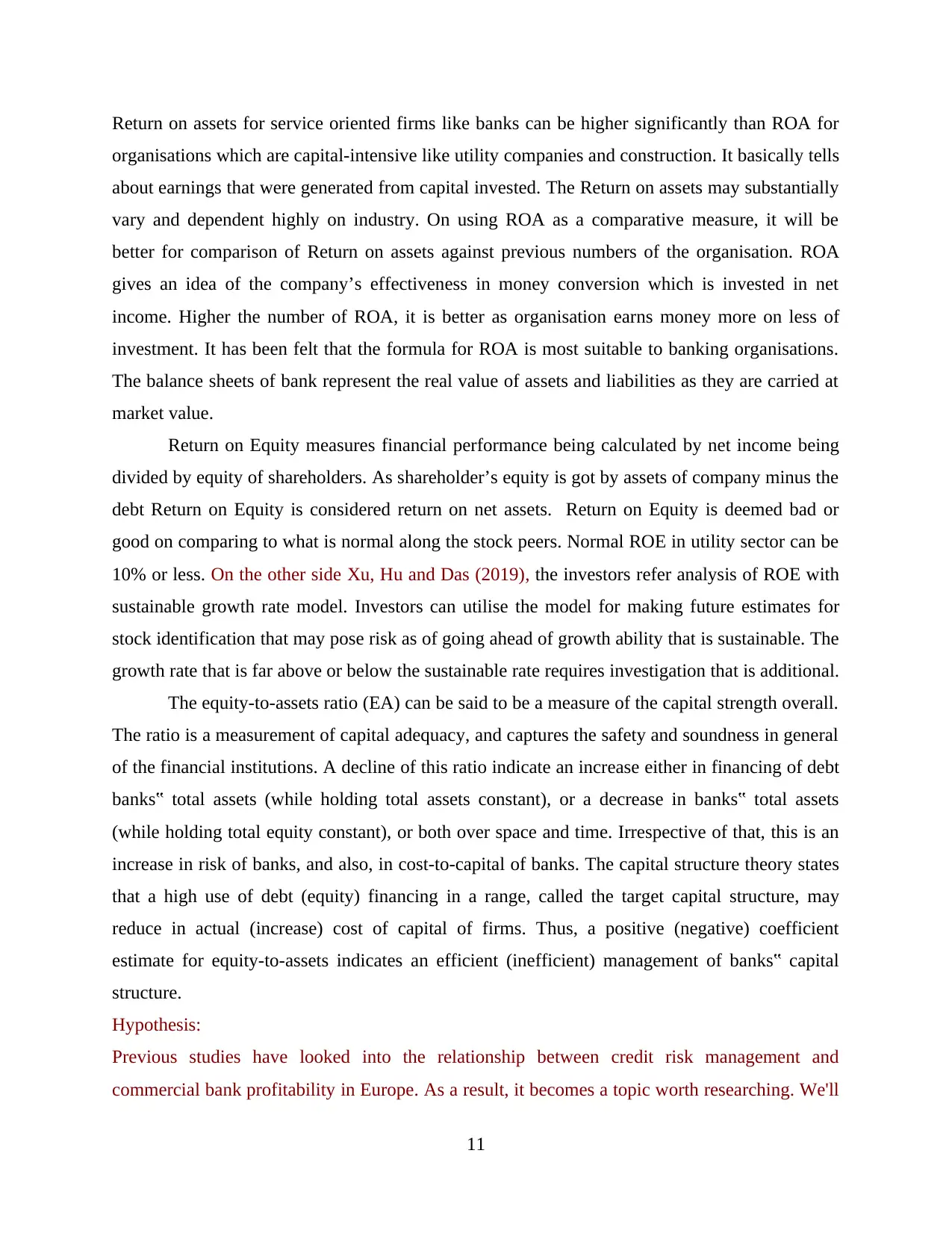
Return on assets for service oriented firms like banks can be higher significantly than ROA for
organisations which are capital-intensive like utility companies and construction. It basically tells
about earnings that were generated from capital invested. The Return on assets may substantially
vary and dependent highly on industry. On using ROA as a comparative measure, it will be
better for comparison of Return on assets against previous numbers of the organisation. ROA
gives an idea of the company’s effectiveness in money conversion which is invested in net
income. Higher the number of ROA, it is better as organisation earns money more on less of
investment. It has been felt that the formula for ROA is most suitable to banking organisations.
The balance sheets of bank represent the real value of assets and liabilities as they are carried at
market value.
Return on Equity measures financial performance being calculated by net income being
divided by equity of shareholders. As shareholder’s equity is got by assets of company minus the
debt Return on Equity is considered return on net assets. Return on Equity is deemed bad or
good on comparing to what is normal along the stock peers. Normal ROE in utility sector can be
10% or less. On the other side Xu, Hu and Das (2019), the investors refer analysis of ROE with
sustainable growth rate model. Investors can utilise the model for making future estimates for
stock identification that may pose risk as of going ahead of growth ability that is sustainable. The
growth rate that is far above or below the sustainable rate requires investigation that is additional.
The equity-to-assets ratio (EA) can be said to be a measure of the capital strength overall.
The ratio is a measurement of capital adequacy, and captures the safety and soundness in general
of the financial institutions. A decline of this ratio indicate an increase either in financing of debt
banks‟ total assets (while holding total assets constant), or a decrease in banks‟ total assets
(while holding total equity constant), or both over space and time. Irrespective of that, this is an
increase in risk of banks, and also, in cost-to-capital of banks. The capital structure theory states
that a high use of debt (equity) financing in a range, called the target capital structure, may
reduce in actual (increase) cost of capital of firms. Thus, a positive (negative) coefficient
estimate for equity-to-assets indicates an efficient (inefficient) management of banks‟ capital
structure.
Hypothesis:
Previous studies have looked into the relationship between credit risk management and
commercial bank profitability in Europe. As a result, it becomes a topic worth researching. We'll
11
organisations which are capital-intensive like utility companies and construction. It basically tells
about earnings that were generated from capital invested. The Return on assets may substantially
vary and dependent highly on industry. On using ROA as a comparative measure, it will be
better for comparison of Return on assets against previous numbers of the organisation. ROA
gives an idea of the company’s effectiveness in money conversion which is invested in net
income. Higher the number of ROA, it is better as organisation earns money more on less of
investment. It has been felt that the formula for ROA is most suitable to banking organisations.
The balance sheets of bank represent the real value of assets and liabilities as they are carried at
market value.
Return on Equity measures financial performance being calculated by net income being
divided by equity of shareholders. As shareholder’s equity is got by assets of company minus the
debt Return on Equity is considered return on net assets. Return on Equity is deemed bad or
good on comparing to what is normal along the stock peers. Normal ROE in utility sector can be
10% or less. On the other side Xu, Hu and Das (2019), the investors refer analysis of ROE with
sustainable growth rate model. Investors can utilise the model for making future estimates for
stock identification that may pose risk as of going ahead of growth ability that is sustainable. The
growth rate that is far above or below the sustainable rate requires investigation that is additional.
The equity-to-assets ratio (EA) can be said to be a measure of the capital strength overall.
The ratio is a measurement of capital adequacy, and captures the safety and soundness in general
of the financial institutions. A decline of this ratio indicate an increase either in financing of debt
banks‟ total assets (while holding total assets constant), or a decrease in banks‟ total assets
(while holding total equity constant), or both over space and time. Irrespective of that, this is an
increase in risk of banks, and also, in cost-to-capital of banks. The capital structure theory states
that a high use of debt (equity) financing in a range, called the target capital structure, may
reduce in actual (increase) cost of capital of firms. Thus, a positive (negative) coefficient
estimate for equity-to-assets indicates an efficient (inefficient) management of banks‟ capital
structure.
Hypothesis:
Previous studies have looked into the relationship between credit risk management and
commercial bank profitability in Europe. As a result, it becomes a topic worth researching. We'll
11
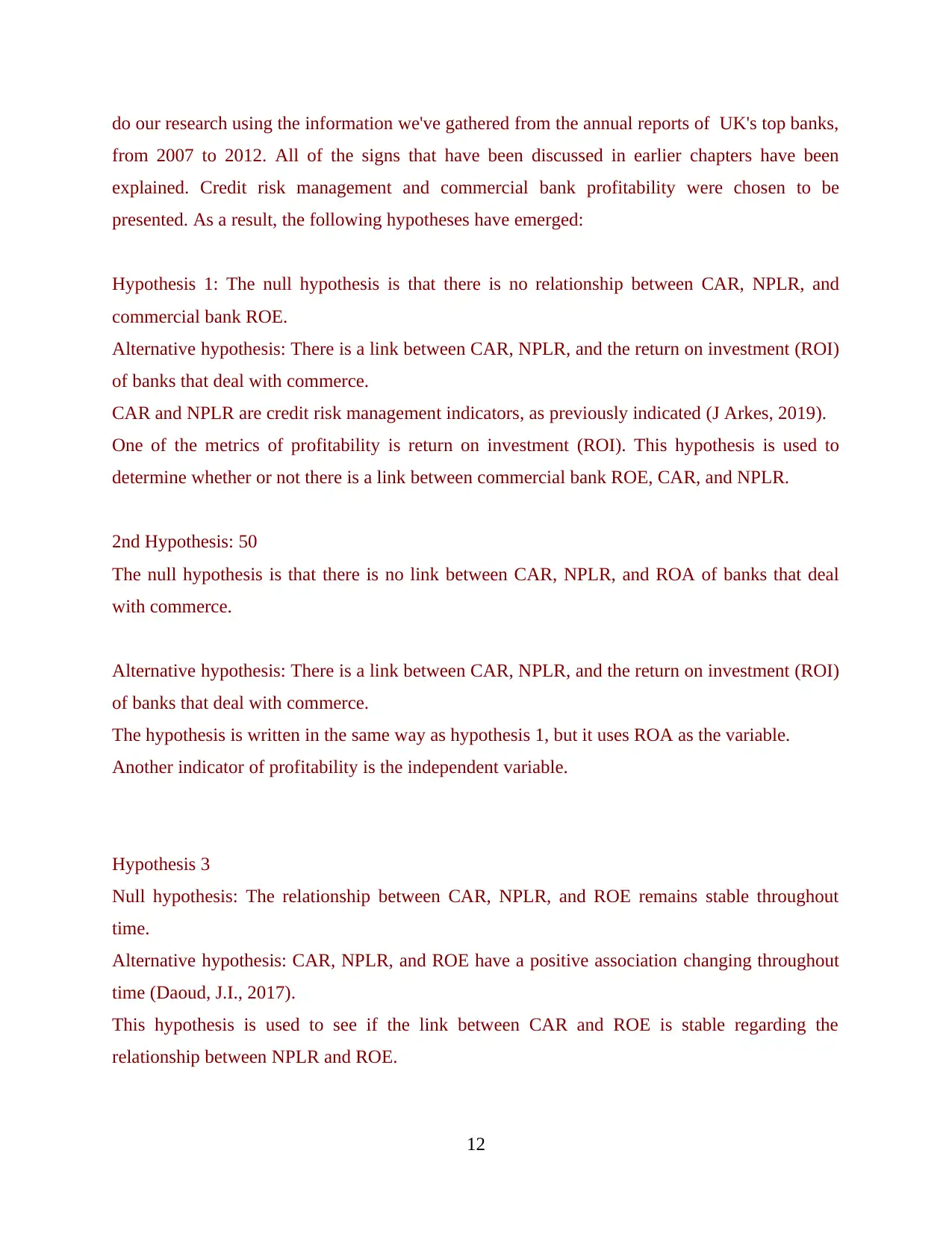
do our research using the information we've gathered from the annual reports of UK's top banks,
from 2007 to 2012. All of the signs that have been discussed in earlier chapters have been
explained. Credit risk management and commercial bank profitability were chosen to be
presented. As a result, the following hypotheses have emerged:
Hypothesis 1: The null hypothesis is that there is no relationship between CAR, NPLR, and
commercial bank ROE.
Alternative hypothesis: There is a link between CAR, NPLR, and the return on investment (ROI)
of banks that deal with commerce.
CAR and NPLR are credit risk management indicators, as previously indicated (J Arkes, 2019).
One of the metrics of profitability is return on investment (ROI). This hypothesis is used to
determine whether or not there is a link between commercial bank ROE, CAR, and NPLR.
2nd Hypothesis: 50
The null hypothesis is that there is no link between CAR, NPLR, and ROA of banks that deal
with commerce.
Alternative hypothesis: There is a link between CAR, NPLR, and the return on investment (ROI)
of banks that deal with commerce.
The hypothesis is written in the same way as hypothesis 1, but it uses ROA as the variable.
Another indicator of profitability is the independent variable.
Hypothesis 3
Null hypothesis: The relationship between CAR, NPLR, and ROE remains stable throughout
time.
Alternative hypothesis: CAR, NPLR, and ROE have a positive association changing throughout
time (Daoud, J.I., 2017).
This hypothesis is used to see if the link between CAR and ROE is stable regarding the
relationship between NPLR and ROE.
12
from 2007 to 2012. All of the signs that have been discussed in earlier chapters have been
explained. Credit risk management and commercial bank profitability were chosen to be
presented. As a result, the following hypotheses have emerged:
Hypothesis 1: The null hypothesis is that there is no relationship between CAR, NPLR, and
commercial bank ROE.
Alternative hypothesis: There is a link between CAR, NPLR, and the return on investment (ROI)
of banks that deal with commerce.
CAR and NPLR are credit risk management indicators, as previously indicated (J Arkes, 2019).
One of the metrics of profitability is return on investment (ROI). This hypothesis is used to
determine whether or not there is a link between commercial bank ROE, CAR, and NPLR.
2nd Hypothesis: 50
The null hypothesis is that there is no link between CAR, NPLR, and ROA of banks that deal
with commerce.
Alternative hypothesis: There is a link between CAR, NPLR, and the return on investment (ROI)
of banks that deal with commerce.
The hypothesis is written in the same way as hypothesis 1, but it uses ROA as the variable.
Another indicator of profitability is the independent variable.
Hypothesis 3
Null hypothesis: The relationship between CAR, NPLR, and ROE remains stable throughout
time.
Alternative hypothesis: CAR, NPLR, and ROE have a positive association changing throughout
time (Daoud, J.I., 2017).
This hypothesis is used to see if the link between CAR and ROE is stable regarding the
relationship between NPLR and ROE.
12
⊘ This is a preview!⊘
Do you want full access?
Subscribe today to unlock all pages.

Trusted by 1+ million students worldwide
1 out of 30
Related Documents
Your All-in-One AI-Powered Toolkit for Academic Success.
+13062052269
info@desklib.com
Available 24*7 on WhatsApp / Email
![[object Object]](/_next/static/media/star-bottom.7253800d.svg)
Unlock your academic potential
Copyright © 2020–2025 A2Z Services. All Rights Reserved. Developed and managed by ZUCOL.




